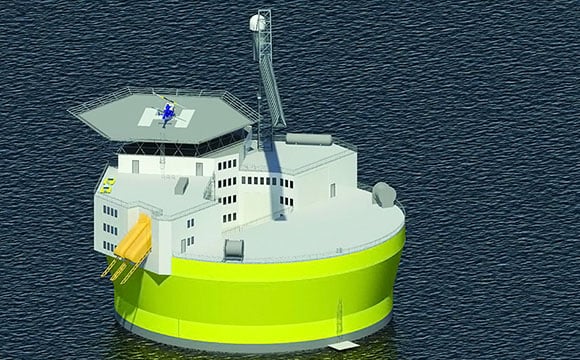
The proposed Offshore Floating Nuclear Plant structure is about 45 meters in diameter, and the plant will generate 300 megawatts of electricity. An alternative design for a 1,100 MW plant calls for a structure about 75 meters (250 feet) in diameter. In both cases, the structures include living quarters and helipads for transporting personnel, similar to offshore oil drilling platforms. Credit: Jake Jurewicz; Justin Knight; MIT
Since nuclear power plants emit no carbon dioxide, they are considered an important component for a greener energy future. A new nuclear power plant promises to be safer, cheaper, and easier to deploy than current plants, but what makes it especially unique is that it will float eight or more miles out to sea.
Many experts cite nuclear power as a critical component of a low-carbon energy future. Nuclear plants are steady, reliable sources of large amounts of power; they run on inexpensive and abundant fuel; and they emit no carbon dioxide (CO2).
A novel nuclear power plant that will float eight or more miles out to sea promises to be safer, cheaper, and easier to deploy than today’s land-based plants. In a concept developed by MIT researchers, the floating plant combines two well-established technologies — a nuclear reactor and a deep-sea oil platform. It is built and decommissioned in a shipyard, saving time and money at both ends of its life. Once deployed, it is situated in a relatively deep water well away from coastal populations, linked to land only by an underwater power transmission line. At the specified depth, the seawater protects the plant from earthquakes and tsunamis and can serve as an infinite source of cooling water in case of emergency — no pumping needed. An analysis of potential markets has identified many sites worldwide with physical and economic conditions suitable for the deployment of a floating plant.
“More than 70 new nuclear reactors are now under construction, but that’s not nearly enough to make a strong dent in CO2 emissions worldwide,” says Jacopo Buongiorno, professor of nuclear science and engineering (NSE) at MIT. “So the question is, why aren’t we building more?”
The offshore floating nuclear plant
The researchers’ vision for an Offshore Floating Nuclear Plant (OFNP) includes a main structure about 45 meters in diameter that will house a plant generating 300 megawatts of electricity. An alternative design for a 1,100-MW plant calls for a structure about 75 meters in diameter. In both cases, the structures include living quarters and helipads for transporting personnel — similar to offshore oil drilling platforms.
Buongiorno cites several challenges to this vision. First, while the fuel is cheap, building a nuclear plant is a long and expensive process often beset by delays and uncertainties. Second, siting any new power plant is difficult: Land near sources of cooling water is valuable, and local objection to construction may be strenuous. And third, the public in several important countries has lost confidence in nuclear power. Many people still clearly remember the 2011 accident at the Fukushima nuclear complex in Japan, when an earthquake created a tsunami that inundated the facility. Power to the cooling pumps was cut, fuel in the reactor cores melted, radiation leaked out, and more than 100,000 people were evacuated from the region.
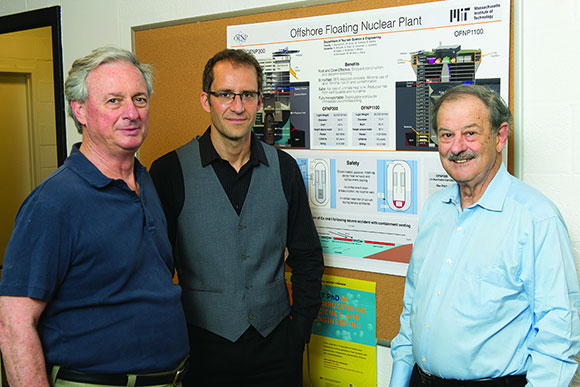
Left to right: Michael Golay and Jacopo Buongiorno of MIT’s Department of Nuclear Science and Engineering (NSE) and Neil Todreas of NSE and the Department of Mechanical Engineering are designing a floating nuclear plant that could provide enhanced safety, easier siting, and centralized construction — and could be deployed in time to play a critical role in a low-carbon energy future. Credit: Jake Jurewicz; Justin Knight; MIT
In light of such concerns, Buongiorno and his team — Michael Golay, professor of NSE; Neil Todreas, the KEPCO Professor of Nuclear Science and Engineering and Mechanical Engineering; and their NSE and mechanical engineering students — have been investigating a novel idea: mounting a conventional nuclear reactor on a floating platform similar to those used in offshore oil and gas drilling, and mooring it about 10 miles out to sea.
The OFNP integrates two well-established technologies with already robust global supply chains. “There are shipyards that build large cylindrical platforms of the type we need and companies that build nuclear reactors of the type we need,” Buongiorno says. “So we’re just combining those two. In my opinion, that’s a big advantage.” By sticking with known technologies, the researchers are minimizing costly and time-consuming development tasks and licensing procedures. Yet they are making changes they think could revolutionize the nuclear option.
Advantages of shipyard construction, offshore siting
According to the researchers’ plan, OFNPs will be built entirely in shipyards, many of which already regularly deal with both oil and gas platforms and large nuclear-powered vessels. The OFNP structure — platform and all — will be built upright on movable skids, loaded onto a transportation ship, and carried out to its site. There, it will be floated off the ship, moored to the seafloor, and connected to the onshore power grid by an underwater power transmission cable. At the end of its life, it will be towed back to the shipyard to be decommissioned — just as nuclear-powered submarines and aircraft carriers are now.
Compared with deploying terrestrial nuclear plants, this process should provide enhanced quality control, standardization, and efficiency. There’s no need to transport personnel, materials, and heavy equipment to a building site — or to clean up after the plant has been retired. The plan also reduces the need for site evaluation and preparation, which contribute to uncertainty and delays. Finally, the OFNP is made mostly of steel, with virtually no need to deal with structural concrete, which, according to Buongiorno, is typically responsible for significant cost overruns and construction delays as well as the emission of substantial quantities of CO2. Taken together, these factors mean that the OFNP can be deployed with unprecedented speed — an important benefit for a project that is highly capital-intensive. “You don’t want to have a large investment lingering out there for eight or 10 years without starting to generate electricity,” Buongiorno says.
The planned site of the floating plant offers other benefits. The OFNP will be situated eight to 12 miles offshore — within the limit of territorial waters — and in water at least 100 meters deep. Thus, it will be far from coastal populations (its only onshore presence will be a small switchyard and a staff and materials management facility), and the deep water beneath it will reduce threats from earthquakes and tsunamis: At that depth, the water absorbs any motion of the ocean floor during earthquakes, and tsunami waves are small. Tsunamis become large and destructive only when they hit the shallow water at the coastline — a concern for nuclear plants built on the shore.
Finally, the open ocean will provide the OFNP with an endless supply of cooling water. If accident conditions arise, seawater can be used to remove heat from the reactor; because the plant is well below the water line, the necessary flows will occur passively, without any pumping and without any seawater contamination. “We won’t lose the ultimate heat sink,” Buongiorno says. “The decay heat, which is generated by the nuclear fuel even after the reactor is shut down, can be removed indefinitely.”
The OFNP thus addresses the three main takeaways from Fukushima cited by Buongiorno: Stay away from dense populations, protect against earthquakes and tsunamis, and never lose cooling to the fuel.
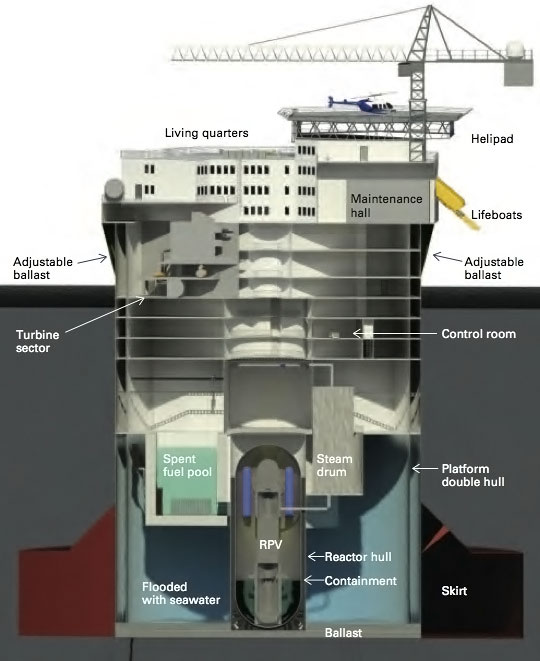
The nuclear reactor and related safety systems of the proposed Offshore Floating Nuclear Plant located in watertight compartments deep in the structure. The reactor pressure vessel (RPV) sits inside a dry containment structure, surrounded by seawater. Steam from generators immersed in the heated water inside the RPV passes to electricity-generating turbines higher in the structure. Every 12 to 48 months, spent fuel assemblies are lifted out, and fresh fuel is inserted into the reactor. The removed assemblies are transferred to the spent fuel pool, which has the storage capacity to handle all fuel removed from the plant over its lifetime. Credit: Jake Jurewicz; Justin Knight; MIT
Designed for efficient operation, enhanced safety
Illustrations accompanying this article present a view of the OFNP in its ocean setting as well as the plant’s key features. The overall structure is upright, cylindrical in shape, and divided into many floors, most of them split into compartments separated by watertight bulkheads. The upper levels house noncritical components such as the living quarters and a helipad. As on oil and gas platforms, workers are brought out by boat or helicopter for three- or four-week shifts. Food, fuel, equipment, and materials for minor maintenance activities are brought out by supply boat, and heavy loads are lifted off by crane.
The nuclear reactor (either a 300-MW or a 1,100-MW unit) and its related safety systems are located in watertight compartments low in the structure to enhance security and safety, provide easy access to ocean water, and give the overall structure a low center of gravity for increased stability. The reactor core and associated critical components are housed within a reactor pressure vessel (RPV), which is located inside a compact structure called the containment. Surrounding the containment — but separated by a gap — is a large chamber that extends to the edge of the cylindrical structure and is constantly flooded with seawater, which enters and exits freely through ports.
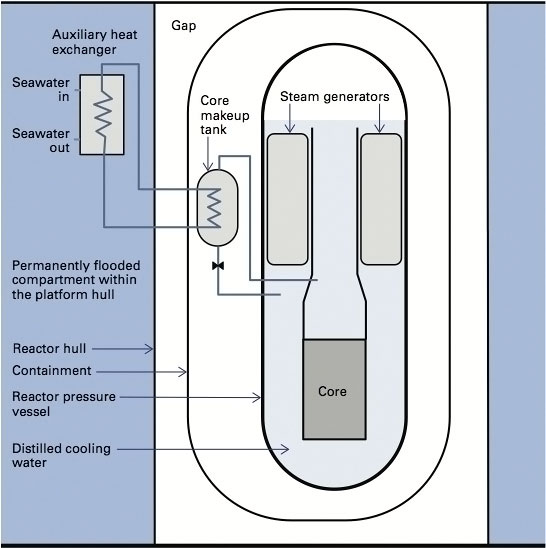
The reactor core and steam generators are immersed in fresh, distilled cooling water inside the reactor pressure vessel (RPV). If operation of the cooling pumps is interrupted, cooling water flows passively through an auxiliary heat exchanger immersed in seawater. If a more serious problem occurs, cooling water is released from inside the RPV into the containment structure, and seawater can enter the empty space around the containment. Heat from the cooling water will pass through the containment wall to the seawater. Seawater flows naturally through the structure, so it is constantly renewed, providing an infinite source of cooling. Credit: Jake Jurewicz; Justin Knight; MIT
Specific design features allow for response to various types of interruptions in normal cooling operations. Generally, pumps bring in cool water from the low ocean layers and discharge the used, heated water to the warm surface layers, thereby preventing “thermal pollution” that can threaten the local ecosystem. If that cooling process is temporarily disrupted, heated water from the reactor is allowed to circulate naturally to a special heat exchanger within the flooded chamber. If a more serious problem (for example, a pipe break) threatens the core, distilled cooling water from inside the RPV is released into the containment (always keeping the core submerged), and seawater from the outside compartment fills the gap around the containment. Heat is efficiently transferred through the containment wall to the seawater, which is constantly and passively renewed. At all times, the cooling water and seawater are kept separate so that contaminants cannot flow from one to the other.
In the unlikely event that, despite continuous heat removal, the pressure inside the containment builds up to dangerous levels, gases from within the containment can be vented into the ocean. However, the gases would first pass through filters to capture cesium, iodine, and other radioactive materials, minimizing their release. Current research is tracking the likely dispersion and dilution of such materials to ensure that any radioactivity in the water remains below acceptable limits even under such extreme circumstances.
Promising economics, abundant potential markets
The MIT team believes that the OFNP may be “a potential game changer” as far as the economics of nuclear power is concerned. It provides the economic advantage of “factory” production of multiple units, yet the units can be large enough to benefit from economies of scale. In addition, unlike any type of terrestrial plant, the OFNP is mobile. “If you build a power plant on land, it remains at the construction location for 40 or 50 years,” says Buongiorno. “But with the OFNP, if after a decade or two you need the generating capacity 100 miles farther up the coast, you can unmoor your floating power plant and move it to the new location.”
The viability of the researchers’ idea depends, of course, on whether there are locations with the necessary physical attributes —deep water relatively near shore but away from busy shipping lanes and frequent massive storms — as well as economic and other incentives for adopting the OFNP.
A detailed analysis identified many potential sites. For example, regions of East and Southeast Asia have limited indigenous resources, a high risk for both earthquakes and tsunamis, and coastal populations in need of power. Countries in the Middle East could use OFNPs to fulfill their domestic needs, freeing up their valuable oil and gas resources for selling. Some countries in coastal Africa and South America rely on power supplied by generators running on imported diesel fuel — an expensive and highly polluting way to go. “Bringing in an OFNP, mooring it close to the coast, and setting up a small distribution system would make a lot of sense — with minimal need for infrastructure development,” says Buongiorno.
Continuing research
The researchers are continuing to work on various aspects of the OFNP. For example, they are developing optimal methods of refueling, a detailed design of the mooring system, and a more thorough model of the plant’s hydrodynamic response in storm waves. In addition, they are establishing a cohesive OFNP protection plan.
The plant design provides considerable security: The reactor is deep in the structure within multiple hulls; the high upper decks permit an unimpeded 360-degree view; and the physical layout minimizes approaches for attackers. Working with security experts, the researchers are now investigating additional strategies involving state-of-the-art sonar and radar systems, submarine netting and booms, and a team of armed security guards.
While much work remains, Buongiorno says, “We anticipate that the first OFNPs could be deployed in a decade and a half — in time to assist the massive growth in nuclear energy use required to combat climate change.”

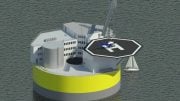



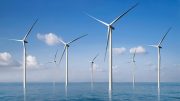
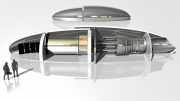

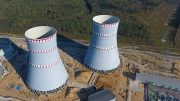
It isn’t bad enough we are stupid enough to have these things on the ocean shore? Floating in the ocean will seem like a great idea until the first one sinks or malfunctions.
Pure idiocy. Nuclear power is the most foolish and irresponsible method of generating electricity, ever conceived by humans.
Mikey. You are so right
Burning focil fuel is worst.
Nothing new here. In the early 1970’s Westinghouse Electric and Tenneco Oil formed a joint corporation called Offshore Power Systems (OPS) with the intent of putting nuclear power plants on barges moored offshore. OPS had a contract to build two floating power plants, Atlantic 1 & 2, for Public Service Gas & Electric of New Jersey. The 1973 Arab Oil Embargo recession and the election of a pro-construction union governor led to the contract’s termination and the ultimate demise of the company.
I don’t see this idea even getting as far as that.
you will be increasing the temperature of the ocean surrounding the site and will be affecting the “flora and fauna”. How are you addressing that?I wish everything you say about this novel system is true and will not have any environmental repercussions. Although I suppose it will be a lesser of two evils.
Do you really believe that the ocean is an “infinite” heat sink?
Good question.
Consider the earth as a “controlled volume.” There will be net zero increase in heat, when considering nuclear. Note that ~50% of the heat from the earth’s core is from fissile material.
Granted your question concerns the localized area around the floating reactor. There will be localized heat gain. Just as seen in all the reactors in use now. But when comparing the heat retention from CO2, CH3, SF6 emission, the strategy of a floating reactor (or nuclear energy in general) would be more environmentally responsibile, provided we do everything right.
The heat into the earth’s control volume would be better controlled with nuclear (minimizing Green House).
Another thing to think about is to consider biorenewable energy as biomass’ BTU content (wood, corn husks, etc)is less damaging as it cycles as heat and plant with decade timescale periodicity. Prehistoric plants’ biomass should be kept sequestered.
I think you have a good question and the recognizing “lesser of two evils” requires looking at the big picture.
Well, Perhaps a full size operational unit using dye and tracers can be set in place and judged after a decade or so? It seems our problem is to charge full speed ahead with an idea and only then discover the faults. And these faults appear like the cracks in the molten salt reactor here in the US or one-in-a-lifetime events like the mistake at Chernobyl or the tsunami injury at DaIchi.
Why we have to have the most dangerous element involved seems counter intuitive to me.
Americans are copying again from the Russians, Russia has been creating this plants since 2000s called the Rosatom project. Please next time research your own, America is just copying Russian and Chinese stuff and blame us China of copying their technology oh please fat americans
The USS Sturgis (MH-1A) was first used as a floating nuclear platform in the 1960s, and worked in the Panama Canal zone until the mid-1970s. No need for petulance based in pointless nationalism and envy. It’s all the same planet we’re working for.
Nah. Don’t use cables. Use the plant to manufacture hydrogen from seawater. Use THAT as fuel anywhere.
Get a Kickstarter rolling and see how many people will back this.. with all the pro-nuke folks on the i-tubes these days it should only be a matter of hours to fill the bucket to build it.
😉
How do we protect it? Could it with stand a underwater mine attack?
OMG, reallY? Everyone with a half brain will realize immediately that this is completely PURE LUNACY. The most stupid recent “green” power design ever, because there is nothing “green” about it.. THINK.. Nuclear waste and nuclear accidents kill people and destroy natural habitat and make land uninhabitable. You want to poison the seas where we get a major portion of our food supply chain from? WTF people.. We already have one power plant that was merely “near” the ocean contaminating hundreds of millions of gallons of seawater that has to be stored on land to keep it from devastating the ocean.. And after this, and it still isn’t finished melting down, that anyone would risk putting one out IN the ocean? What kind of mad men are these people? How you going to contain an accident there? It will pollute the entirety of the ocean without control. NUCLEAR POWER IS NOT GREEN, IT IS NOT SAFE, IT IS A TIME BOMB, AND BOMB IS THE KEY WORD. DO NOT DO THIS TO OUR PLANET. It’s time to mothball all these nuclear plants. As it is we have hundreds of millions of tons of spend nuclear fuel that we don’t know what to do with that will have to be somehow stored for hundreds of thousands of years out in some hole in the desert somewhere where nobody wants it anywhere near where they live, potential for leakage is high given the time scale, and the consequences of leakage could be catastrophic and someone wants to add more to such a wonderful legacy? Folly! Completely ignorant of history which proves the reality of Murphy’s law and exactly why this is a.REALLY REALLY DUMB IDEA folks…. Nothing to see here, move along… Only someone like Donald Trump would think this was a wise plan to follow…. Do us a favor and burn the plans for this and never mention it to him. Thanks much for the kind attention to this unethical idea to make a few hundred megawatts at risk of the entire ocean and millions of people near it and elsewhere who will starve if you kill our oceans with cancer causing waters and mutate the fish so they can’t bread anymore or consumed and they all die and then we begin to die as the cancerous contaminated ocean water gets taken into the skies by natural processes and rains radioactive rain down on the land too. What a STUPID STUPID STUPID STUPID –Can I dare say again STUPID IDEA!! WTF are they thinking? (Clearly, they have no thought on anything but money and lets see what else we can do with nuclear!—not a single thought about wether or not it is wise or proper that we should do it)…. And terrorism? How you gonna control access to one of these when its out there? You gone have guards parked in a circle of warships around it, and an anti-missile installation? What a bunch of dumb-clucks. This is the worst thing I’ve EVER heard of hands down.
Hi Greta!
To add a more constructive comment now the shock of this dumb idea has somewhat passed, the risk of this is far out-weighing the cost and the benefits of such with much cheaper land-based alternatives available to generate power that don’t use risky materials on the Periodic Table of Elements. We can solve all of our energy demands within a 50 x 50 mile area of desert using the most efficient solar energy capturing methods and molten salt, pumped water, hydrogen splitting or mega-battery technologies to make that power relevant 24/7/365 for all of our needs. We can do that and mothball all existing nuclear plants for safety and come to our senses by taking the more prudent, safe for the long run sustainable course of action. We must quit thinking in time scales or 10-30 years and start thinking in terms of what will this do 50 years, 75 years, 100 years down the road, can this be maintained, is is safe to decommission and rebuild or will it be maintainable over time? Does it risk the environment with any super-incidents of any kind? This is the kind of questions we need to ask before approving any more permits, new designs, or new technologies.
Why are we considering Nuclear when photovoltaic has such a clear advantage in our biosphere? Here, on our jewel of a planet, that seems an unnecessary risk.
Is there a news blackout on thorium?
Reactors are modular and reusable, cheaper,
scalable in size, with low-density reactive material – cannot melt down.
Waste is far less dangerous than plutonium, and is radioactive for only 500 years. (Yes that’s twice as long as any modern civilization). No bomb-making materials are produced. These reactors can even digest plutonium, cutting down some of that waste problem.
We would have had thorium reactors all along if it weren’t for the fact that atomic energy was under military jurisdiction and they wanted the fission reactors’ plutonium byproduct to make atomic bombs.
If desperation dictates nuclear, thorium would faster to deploy to more places.
The one issue not mentioned in the article is one of the most important: disposal of nuclear waste, which is very dangerous and long-lived. Dealing with it is not cheap and contamination possibilities are very high. How does one safely sequester nuclear waste with a half-life of 10,000 years or so? I doubt that it can be done.